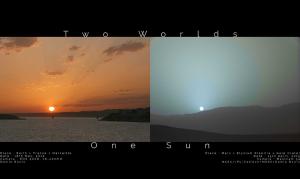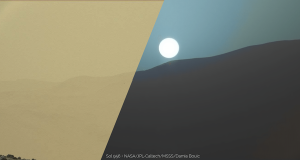Blog
Two Worlds, One Sun
18 May 2015
 NASA / JPL-Caltech / MSSS / Damia Bouic
NASA / JPL-Caltech / MSSS / Damia BouicThere’s an image going around of a blue sunset on Mars. Yes, it’s a real image, and yes, the colors are reasonably true to life. It was taken by the Curiosity rover in April. Given that sunsets on Earth are typically red, how does Mars get a blue sunset? It all has to do with the way light scatters in the atmospheres of Earth and Mars.
Earth has a relatively thick atmosphere, so most of the atmospheric scattering occurs when light strikes a molecule of air, known as Rayleigh scattering. Rayleigh scattering occurs when the object a photon scatters off (the air molecule) is much smaller than the wavelength of the photon. The closer the wavelength is to the size of the molecule, the more likely it is to scatter. This means that red wavelengths (which are the longer wavelengths of visible light) don’t scatter with air molecules much, while blue wavelengths (which are shorter) tend to scatter a lot. In fact blue light is almost 10 times more likely to scatter against air molecules than red light. This is why the sky appears blue, since so much of the blue light is scattered.
When the Sun is low in the sky, it’s light has to travel a long path through the atmosphere to reach you. As the light travels through the atmosphere some of the photons are scattered off the air molecules. When the photons scatter off air molecules, they scatter randomly in all directions, so usually when a photon scatters, it scatters away from your line of sight. Since blue photons scatter much more often than red ones, much of the blue light is scattered away. This leaves red photons to reach your eye. Hence the Sun looks red when low in the sky. When the Sun is overhead, the path it takes to reach you is much shorter, so only a bit of the blue light is scattered. So the Sun looks yellow.
 NASA / JPL-Caltech / MSSS / Damia Bouic
NASA / JPL-Caltech / MSSS / Damia BouicMars has a much thinner atmosphere, so the amount of Rayleigh scattering is much less. But Mars also has a dry, dusty surface, and a weaker surface gravity, so the atmosphere of Mars is often filled with fine dust particles. These particles are more comparable in size to the wavelengths of visible light, so most of the light is scattered by Mie scattering. One of the main differences between Rayleigh and Mie scattering is that Rayleigh scattering tends to occur in all directions, but Mie scattering varies with scattering angle. What this means is that longer wavelengths (reds) tend to scatter more uniformly, while shorter wavelengths (blues) tend to scatter at slight angles. This means that blue light tends to be deflected less than red light. This means Mars can have a dusty red daytime sky, and a blue sunset.
Mie scattering does occur on Earth as well, but since Mie scattering is less efficient than Rayleigh scattering it’s never strong enough to give us a blue sunset. It can (rarely) produce a blue moon. The most widespread incidence of modern history occurred after the eruption of Krakatoa in 1883, which sent so much ash into the atmosphere it produced brilliantly red sunsets and visibly blue moons all across the globe for nearly two years. As a result, the phrase “once in a blue moon” came to mean a rare occurrence.